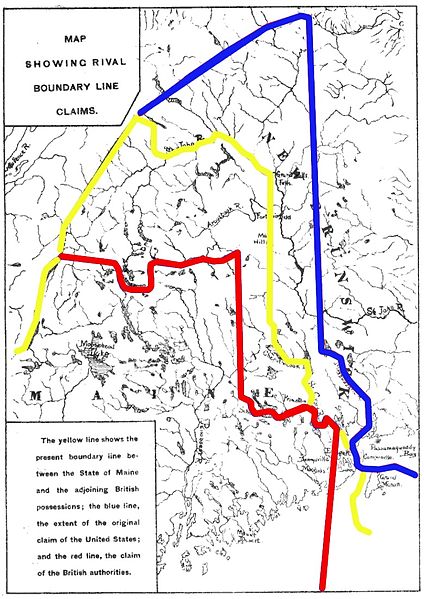The Webster–Ashburton Treaty, signed August 9, 1842, was a treaty that resolved several border issues between the United States and the British North American colonies. Signed under John Tyler's presidency, it resolved the so-called Aroostook War. The provisions of the treaty included:The settlement of the location of the Maine–New Brunswick border, which was the primary cause of the Aroostook War.
Establishment of the border between Lake Superior and the Lake of the Woods, originally defined in the Treaty of Paris in 1783;
Reaffirmation of the location of the border in the westward frontier up to the Rocky Mountains defined in the Treaty of 1818;
Definition of seven crimes subject to extradition;
Agreement that the two parties would share use of the Great Lakes;
Agreement that there should be a final end to the slave trade on the high seas.
Webster–Ashburton Treaty ratification
Plaque in Washington, D.C.
Maine boundary dispute that led to the 1842 Webster–Ashburton Treaty
John Tyler was an American politician who served as the tenth president of the United States from 1841 to 1845, after briefly holding office as the tenth vice president in 1841. He was elected vice president on the 1840 Whig ticket with President William Henry Harrison, succeeding to the presidency following Harrison's death 31 days after assuming office. Tyler was a stalwart supporter and advocate of states' rights, including regarding slavery, and he adopted nationalistic policies as president only when they did not infringe on the states' powers. His unexpected rise to the presidency posed a threat to the presidential ambitions of Henry Clay and other Whig politicians and left Tyler estranged from both of the nation's major political parties at the time.
Tyler's birthplace, Greenway Plantation in Charles City County, Virginia
Woodburn Plantation, Tyler's residence 1813–1821
An engraving of Tyler (c. 1826) as governor of Virginia
"Tippecanoe and Tyler Too"







